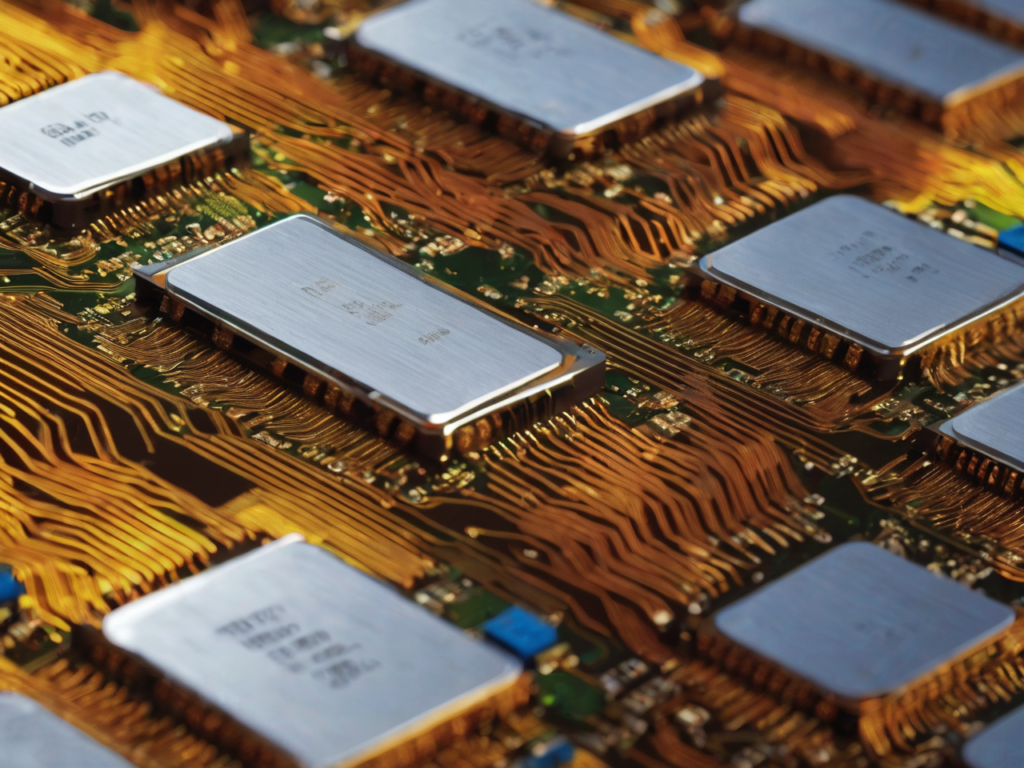Wish someone could save their memory just like they showed us in Harry Potter movies and perhaps someone could access those at a later point in time and view realistically what it contained. Movies and Sci-fi stuff aside, memory has always been an interesting topic. We just want to have better and more. We are greedy for it. In the ever-evolving landscape of technology, computer memory stands as a fundamental component that has played a crucial role in the development and performance of computers. From the early days of computing to the sophisticated systems of today, memory has undergone significant transformations, evolving in capacity, speed, and architecture. This article delves into the history, current trends, and future of computer memory, providing a comprehensive understanding of its critical role in modern computing.
Computer memory, often referred to as RAM (Random Access Memory) and storage, serves as the brain of a computer, holding data that the CPU (Central Processing Unit) needs to access quickly. The history of computer memory is a fascinating journey that mirrors the broader advancements in computing technology. Initially, memory was limited and expensive, with early computers relying on technologies like punched cards and magnetic drums. Over time, innovations such as magnetic core memory, semiconductor memory, and dynamic RAM (DRAM) have revolutionized the field, making memory more affordable, faster, and capable of storing vast amounts of data.
Today, the performance of a computer is largely determined by the efficiency of its memory. As we witness the rise of technologies like cloud computing, artificial intelligence, and big data, the demand for faster and more efficient memory continues to grow. Modern memory technologies, including DDR5, GDDR6, and NVMe SSDs, are pushing the boundaries of speed and capacity, enabling computers to handle more complex tasks with ease.
This article explores the historical development of computer memory, its current state, and the latest trends shaping its future. It also addresses the key challenges and questions that have arisen as memory technology continues to evolve. Whether you’re a tech enthusiast, a professional in the field, or simply curious about the inner workings of computers, this article offers valuable insights into the world of computer memory.
The History of Computer Memory
Early Memory Technologies
The history of computer memory dates back to the early days of computing, where memory was a scarce and valuable resource. The first computers, such as the ENIAC (Electronic Numerical Integrator and Computer), did not have what we consider memory today. Instead, they used punched cards and magnetic drums to store data. These early forms of memory were slow and cumbersome, but they laid the groundwork for future innovations.
Magnetic Core Memory, introduced in the 1950s, was one of the first breakthroughs in memory technology. It used small magnetic rings, or cores, to store bits of information. This type of memory was non-volatile, meaning it retained data even when the power was turned off. Magnetic core memory became the standard for computers in the 1960s and was a significant improvement over previous methods.
The Transition to Semiconductor Memory
The next major advancement in computer memory came with the development of semiconductor memory in the 1960s. Semiconductor memory used transistors to store data, which allowed for much faster access times and greater storage capacity compared to magnetic core memory. The first type of semiconductor memory was Static RAM (SRAM), which stored data in flip-flops and required a constant power supply to maintain its state.

Dynamic RAM (DRAM), introduced in the 1970s, was another significant development. Unlike SRAM, DRAM used a single capacitor and transistor per bit, allowing for much higher density and lower cost. DRAM quickly became the dominant form of computer memory and remains so today, with various improvements and iterations over the decades.
The Advent of Solid-State Drives (SSDs)
The late 20th century saw the emergence of Solid-State Drives (SSDs), which used NAND flash memory to store data. Unlike traditional hard drives, which relied on spinning disks to read and write data, SSDs had no moving parts, making them much faster and more reliable. SSDs revolutionized the storage industry and became increasingly popular in the 2000s as prices dropped and capacities increased.
Latest Trends in Computer Memory
DDR5 and GDDR6: The Next Generation of RAM
One of the most significant recent developments in computer memory is the introduction of DDR5 (Double Data Rate 5) RAM. DDR5 offers several improvements over its predecessor, DDR4, including higher data transfer rates, increased bandwidth, and better power efficiency. DDR5 is designed to handle the demands of modern computing, such as gaming, video editing, and AI applications.
GDDR6 (Graphics Double Data Rate 6) is another important advancement, particularly in the realm of graphics memory. GDDR6 provides higher bandwidth and lower power consumption than previous generations, making it ideal for high-performance graphics cards and gaming systems. As gaming and AI applications become more complex, the demand for faster and more efficient memory like GDDR6 continues to grow.
Non-Volatile Memory Express (NVMe): Revolutionizing Storage
Another trend shaping the future of computer memory is the rise of NVMe (Non-Volatile Memory Express) SSDs. NVMe is a protocol that allows for faster communication between the storage device and the CPU by taking advantage of the high-speed PCIe (Peripheral Component Interconnect Express) bus. NVMe SSDs offer significantly faster read and write speeds compared to traditional SATA SSDs, making them ideal for tasks that require quick data access, such as video editing, gaming, and large-scale data analysis.
NVMe has become the standard for high-performance storage in both consumer and enterprise systems. As data-intensive applications continue to proliferate, the demand for NVMe storage is expected to grow, driving further innovations in this space.
3D XPoint and Optane Memory: Bridging the Gap Between RAM and Storage
Intel and Micron’s development of 3D XPoint memory, marketed as Intel Optane, represents another exciting trend in computer memory. 3D XPoint is a non-volatile memory technology that offers higher performance and endurance than traditional NAND flash memory. Optane memory can be used as both a cache for traditional storage devices and as primary storage, providing faster access to frequently used data.
Optane memory is particularly beneficial in scenarios where large amounts of data need to be accessed quickly, such as in data centers and high-performance computing environments. It bridges the gap between RAM and storage, offering a unique solution for improving system performance.
Memory Scalability and Integration
As the demand for memory continues to grow, so does the need for scalable and integrated memory solutions. Technologies like High Bandwidth Memory (HBM) and Hybrid Memory Cube (HMC) are designed to provide higher bandwidth and lower power consumption by integrating memory more closely with the CPU and GPU. These technologies are particularly important in data centers and AI applications, where large amounts of data need to be processed quickly and efficiently.
The trend toward memory integration is also evident in the development of Compute Express Link (CXL), a new interconnect standard that allows for more efficient sharing of memory resources between CPUs, GPUs, and other accelerators. CXL is expected to play a crucial role in the future of computing, particularly in the context of AI and machine learning workloads.
Performance Considerations
Speed and Latency
The performance of computer memory is primarily determined by two factors: speed and latency. Speed refers to the rate at which data can be read from or written to memory, while latency is the delay between the request for data and the start of data transfer. Higher memory speed and lower latency are essential for improving overall system performance, particularly in tasks that require quick access to large amounts of data, such as gaming, video editing, and scientific computing.
Capacity and Scalability
As applications become more data-intensive, the demand for higher memory capacity continues to grow. Modern memory technologies, such as DDR5 and HBM, offer greater scalability, allowing for larger memory capacities without sacrificing performance. This is particularly important in data centers, where large-scale data processing requires vast amounts of memory.
Power Efficiency
Power efficiency is another critical consideration in memory performance, particularly in portable devices like laptops and smartphones. Modern memory technologies, such as LPDDR5 (Low Power DDR5) and GDDR6, are designed to offer higher performance while consuming less power. This is achieved through various techniques, such as reducing the voltage required for data transfer and optimizing the memory architecture for lower power consumption.
Reliability and Endurance
Reliability and endurance are also important factors in memory performance, particularly in enterprise environments where data integrity is critical. Modern memory technologies, such as ECC (Error-Correcting Code) memory and Optane, offer improved reliability by detecting and correcting errors that may occur during data transfer. This is particularly important in applications where data accuracy is paramount, such as financial transactions and scientific research.
Challenges and Future Directions
Scaling Challenges
One of the primary challenges in the development of computer memory is scaling. As memory manufacturers strive to increase capacity and performance, they face the challenge of fitting more transistors and capacitors into smaller spaces. This has led to the development of 3D memory technologies, such as 3D NAND and 3D XPoint, which stack memory cells vertically to increase density.
However, scaling comes with its own set of challenges, such as increased heat generation and power consumption. To address these issues, researchers are exploring new materials and architectures that can improve memory performance without compromising efficiency.
Emerging Memory Technologies
As traditional memory technologies approach their physical limits, researchers are exploring new and emerging memory technologies that could revolutionize the field. Some of the most promising technologies include Resistive RAM (ReRAM), Magnetoresistive RAM (MRAM), and Phase-Change Memory (PCM). These technologies offer the potential for higher performance, lower power consumption, and greater scalability compared to traditional memory.

For example, ReRAM uses resistive switching materials to store data, allowing for faster and more efficient data transfer. MRAM, on the other hand, uses magnetic states to store data, offering non-volatility and high endurance. PCM uses the phase change of materials to store data, providing a unique combination of speed and endurance.
Quantum Memory
Another exciting area of research is quantum memory, which leverages the principles of quantum mechanics to store and process data. Quantum memory has the potential to revolutionize computing by enabling the storage and manipulation of quantum bits (qubits), which can represent multiple states simultaneously. This could lead to significant advancements in fields such as cryptography, materials science, and artificial intelligence.
While quantum memory is still in its early stages of development, researchers are making significant progress in this area. The eventual realization of quantum memory could open up new possibilities for computing, pushing the boundaries of what is currently possible with traditional memory technologies.
Cutting Edge Memory Modules Compared
Technology progresses very fast. Here’s a comparison of the latest and upcoming memory modules in a tabular format:
| Feature | DDR5 | GDDR6 | LPDDR5X |
|---|---|---|---|
| Type | Dynamic Random Access Memory (DRAM) | Graphics Double Data Rate (GDDR) | Low Power Double Data Rate (LPDDR) |
| Primary Use | General-purpose computing, servers | Graphics cards, gaming consoles | Mobile devices, laptops, tablets |
| Release Year | 2020 | 2018 | 2021 |
| Data Transfer Rate | Up to 6.4 Gbps per pin | Up to 16 Gbps per pin | Up to 8.5 Gbps per pin |
| Bandwidth | Up to 51.2 GB/s (per module) | Up to 672 GB/s (per chip) | Up to 68 GB/s (per module) |
| Voltage | 1.1V | 1.35V | 0.5V to 1.1V |
| Power Efficiency | Improved over DDR4 | Lower power consumption than GDDR5 | Significantly better than LPDDR5 |
| Capacity | Up to 64 GB per module | Typically 1-2 GB per chip | Up to 16 GB per module |
| Latency | Improved latency over DDR4 | Low latency for high-speed graphics | Optimized for low power and latency |
| Notable Features | – Increased memory density – ECC support (Error Correction Code) | – High bandwidth for gaming – Improved power efficiency | – Optimized for mobile power consumption – Enhanced data protection features |
| Upcoming Developments | DDR5X with higher speeds and efficiency | GDDR6X with PAM4 signaling for faster speeds | LPDDR6 expected with further speed and power efficiency improvements |
Key Highlights:
- DDR5: Offers significant improvements in bandwidth and capacity, making it ideal for high-performance computing environments.
- GDDR6: Tailored for graphics processing, with high bandwidth and low latency, driving next-gen gaming and professional graphics applications.
- LPDDR5X: Optimized for mobile devices, providing high speeds with low power consumption, crucial for extending battery life in portable electronics.
These memory modules represent the cutting edge of current and upcoming memory technologies, each designed to meet the specific demands of different computing environments.
Top 10 Important Questions and Answers About Computer Memory
- What is the primary difference between RAM and storage?
- RAM (Random Access Memory) is a type of volatile memory that temporarily stores data that the CPU needs to access quickly. Storage, on the other hand, refers to non-volatile memory, such as SSDs or HDDs, that stores data permanently. RAM is faster but has less capacity, while storage has higher capacity but slower access times.
- How does DDR5 improve over DDR4?
- DDR5 offers higher data transfer rates, increased bandwidth, and better power efficiency compared to DDR4. It also supports larger memory capacities, making it ideal for data-intensive applications like gaming and AI.
- What is the significance of NVMe in modern computing?
- NVMe is a protocol that allows for faster communication between storage devices and the CPU, taking advantage of the high-speed PCIe bus. NVMe SSDs offer significantly faster read and write speeds compared to traditional SATA SSDs, making them ideal for tasks that require quick data access.

- What are the advantages of using GDDR6 memory in graphics cards?
- GDDR6 provides higher bandwidth and lower power consumption compared to previous generations, making it ideal for high-performance graphics cards. It enables faster rendering and smoother gameplay in demanding gaming and graphics applications.
- How does 3D XPoint memory differ from traditional NAND flash?
- 3D XPoint memory, marketed as Intel Optane, offers higher performance and endurance than traditional NAND flash. It can be used as both a cache for traditional storage devices and as primary storage, providing faster access to frequently used data.
- What challenges do memory manufacturers face in scaling memory technology?
- Memory manufacturers face challenges in fitting more transistors and capacitors into smaller spaces as they strive to increase capacity and performance. This leads to issues such as increased heat generation and power consumption, which require innovative solutions like 3D memory technologies.
- What are some emerging memory technologies that could shape the future of computing?
- Emerging memory technologies include Resistive RAM (ReRAM), Magnetoresistive RAM (MRAM), and Phase-Change Memory (PCM). These technologies offer the potential for higher performance, lower power consumption, and greater scalability compared to traditional memory.
- What is quantum memory, and how could it impact the future of computing?
- Quantum memory leverages the principles of quantum mechanics to store and process data, enabling the storage and manipulation of quantum bits (qubits). Quantum memory could revolutionize fields such as cryptography, materials science, and artificial intelligence by pushing the boundaries of what is currently possible with traditional memory technologies.
- How does memory latency impact system performance?
- Memory latency refers to the delay between the request for data and the start of data transfer. Lower latency is essential for improving overall system performance, particularly in tasks that require quick access to large amounts of data, such as gaming, video editing, and scientific computing.
- What role does memory integration play in modern computing?
- Memory integration, as seen in technologies like High Bandwidth Memory (HBM) and Compute Express Link (CXL), allows for more efficient sharing of memory resources between CPUs, GPUs, and other accelerators. This is particularly important in data centers and AI applications, where large amounts of data need to be processed quickly and efficiently.
Conclusion
The evolution of computer memory is a testament to the relentless pursuit of speed, efficiency, and capacity in the computing world. From the early days of punched cards and magnetic drums to the latest innovations in DDR5, NVMe, and quantum memory, the journey of memory technology reflects the broader advancements in computing.
As we move forward, the challenges of scaling, power efficiency, and integration will continue to drive innovation in memory technology. Emerging technologies like ReRAM, MRAM, and quantum memory hold the promise of revolutionizing the way we store and process data, opening up new possibilities for computing.
For those interested in the inner workings of computers, understanding the history and trends of computer memory is essential. As memory technology continues to evolve, it will play an increasingly important role in shaping the future of computing, enabling new applications and pushing the boundaries of what is possible.
In a world where data is king, the importance of efficient, reliable, and fast memory cannot be overstated. Whether you are a gamer, a data scientist, or simply a technology enthusiast, the advancements in memory technology will continue to impact your digital experience in profound ways.
Delightful Reads






청도페이스라인출장